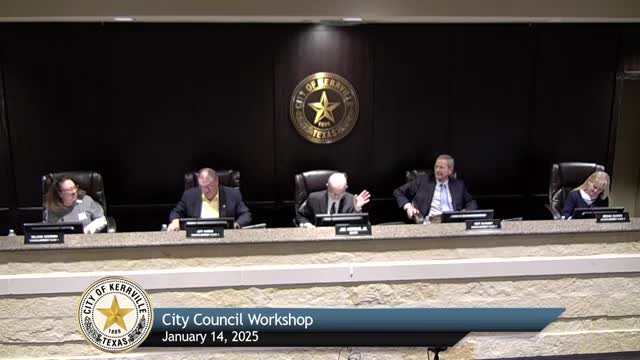Council advances draft tree-preservation ordinance for future developments, debates exemptions for small residential lots
January 15, 2025 | Kerrville, Kerr County, Texas
This article was created by AI summarizing key points discussed. AI makes mistakes, so for full details and context, please refer to the video of the full meeting. Please report any errors so we can fix them. Report an error »

Kerrville City Council and planning staff discussed a draft tree-preservation ordinance at the Jan. 14, 2025 workshop as part of implementing the Kerrville 2050 plan. The draft would require tree surveys and retention or replacement standards for protected trees when developers undertake new development activity on unplatted parcels within city limits.
“Your house, your house, this doesn't apply to you. It applies to people who want to develop new properties,” the mayor said while explaining the ordinance’s intent to the public. Planning staff, Drew, told council the ordinance breaks protected trees into two categories—standard and heritage—and also applies separate preservation requirements for properties within the 100-year floodplain. Staff showed a GIS map identifying 319 vacant, unplatted parcels inside the current city limits that would fall under the draft rules.
The draft defines development to include construction activities and any clearing, grading, excavation or filling that may damage or destroy a protected tree. Protected trees are identified by species and diameter thresholds; staff said standard large species of 8 inches diameter and larger would be inventoried and, depending on category, a required percentage would be retained or replaced. Staff noted aggressive invasive species are listed as not recommended for planting.
Councilmembers raised several concerns and possible refinements. Councilmember Brenda asked whether lots of an acre or smaller—where single-family homes are most likely—could be excluded, citing homeowners’ need to replace or reconfigure a house footprint. Several councilmembers and staff said a blanket exemption for single-family residences could be simpler: “If it's a single family residence, I think it'd be alright,” one councilmember said. Staff said exempting single-family construction or applying an acreage threshold could be drafted between readings, and that a variance process would remain for hardship cases.
Councilmember McKinney and others stressed the draft provides flexibility: for most trees between 8 and 24 inches the draft requires keeping 40 percent; for heritage trees (24 inches or larger) it requires keeping 60 percent, and applicants can replant or pay a fee-in-lieu if they remove more than the preservation requirement.
Councilmembers referenced past contentious removals, including a widely noticed tree removal on Water Street, but both staff and the mayor clarified the draft ordinance predates that incident and is tied to the 2050 plan. The council directed staff to prepare revisions that clarify exemptions and to return with amended language and pricing or implementation considerations; staff noted the draft draws on model ordinances from other Texas communities.
The council indicated a desire to advance a workable ordinance rather than delay indefinitely, and staff said the exemption language would be a primary focus in the next draft.
“Your house, your house, this doesn't apply to you. It applies to people who want to develop new properties,” the mayor said while explaining the ordinance’s intent to the public. Planning staff, Drew, told council the ordinance breaks protected trees into two categories—standard and heritage—and also applies separate preservation requirements for properties within the 100-year floodplain. Staff showed a GIS map identifying 319 vacant, unplatted parcels inside the current city limits that would fall under the draft rules.
The draft defines development to include construction activities and any clearing, grading, excavation or filling that may damage or destroy a protected tree. Protected trees are identified by species and diameter thresholds; staff said standard large species of 8 inches diameter and larger would be inventoried and, depending on category, a required percentage would be retained or replaced. Staff noted aggressive invasive species are listed as not recommended for planting.
Councilmembers raised several concerns and possible refinements. Councilmember Brenda asked whether lots of an acre or smaller—where single-family homes are most likely—could be excluded, citing homeowners’ need to replace or reconfigure a house footprint. Several councilmembers and staff said a blanket exemption for single-family residences could be simpler: “If it's a single family residence, I think it'd be alright,” one councilmember said. Staff said exempting single-family construction or applying an acreage threshold could be drafted between readings, and that a variance process would remain for hardship cases.
Councilmember McKinney and others stressed the draft provides flexibility: for most trees between 8 and 24 inches the draft requires keeping 40 percent; for heritage trees (24 inches or larger) it requires keeping 60 percent, and applicants can replant or pay a fee-in-lieu if they remove more than the preservation requirement.
Councilmembers referenced past contentious removals, including a widely noticed tree removal on Water Street, but both staff and the mayor clarified the draft ordinance predates that incident and is tied to the 2050 plan. The council directed staff to prepare revisions that clarify exemptions and to return with amended language and pricing or implementation considerations; staff noted the draft draws on model ordinances from other Texas communities.
The council indicated a desire to advance a workable ordinance rather than delay indefinitely, and staff said the exemption language would be a primary focus in the next draft.
View full meeting
This article is based on a recent meeting—watch the full video and explore the complete transcript for deeper insights into the discussion.
View full meeting
